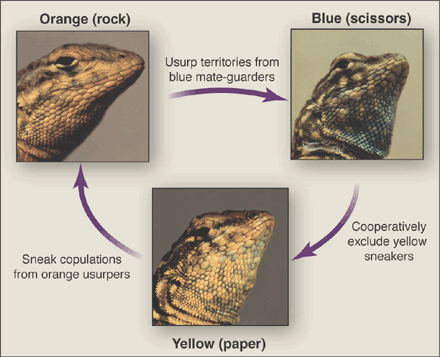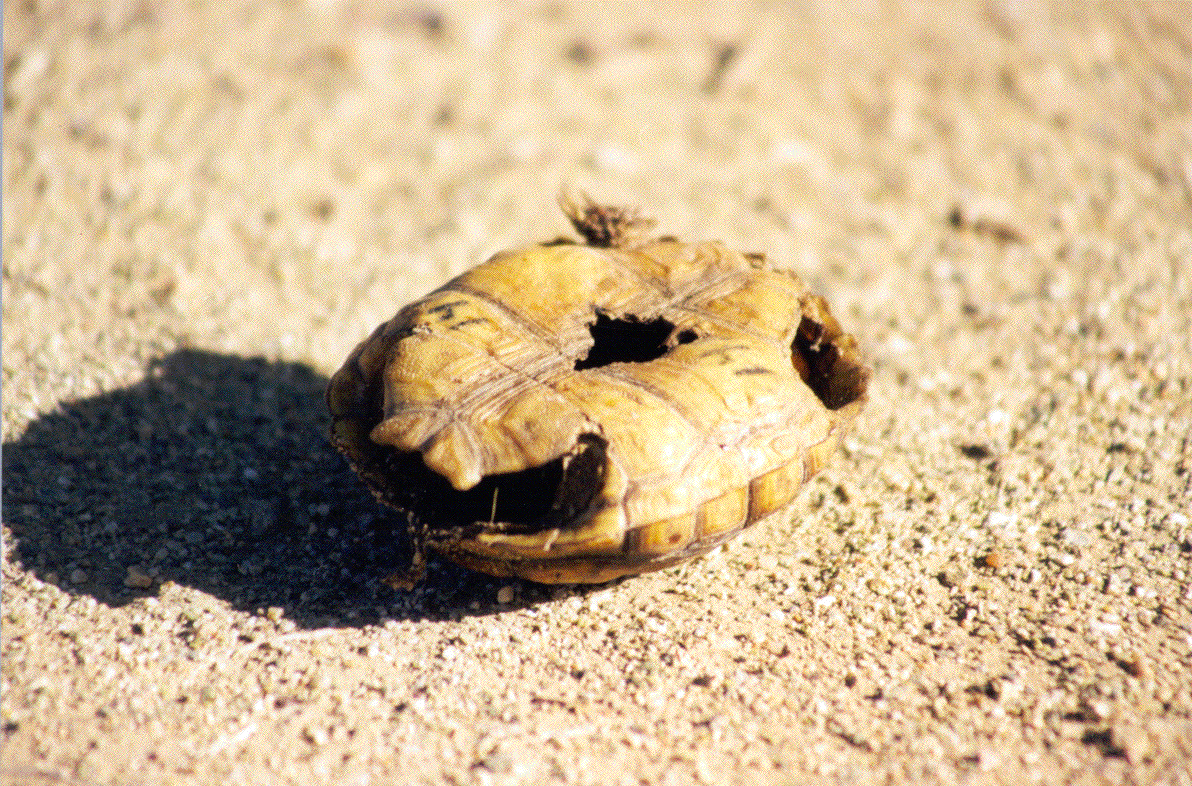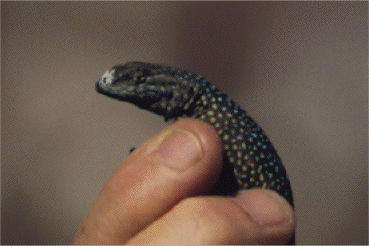CURRENT AND PAST RESEARCH
Evolutionary
physiology of side-blotched lizards
Nutritional
physiology of juvenile desert tortoises
Dispersal by
head-started desert tortoises
Osmoregulatory
physiology of desert and intertidal lizards
Evolution of
salt glands in lizards
Evolutionary physiology of side-blotched
lizards: correlational selection on performance
A key issue in evolutionary physiology has been the difficulty
in linking physiological traits directly with evolutionary forces
(natural selection, sexual selection, etc.). The research I am
currently conducting with Barry Sinervo at UC Santa Cruz uses
complementary approaches (lab and field-based studies, under natural
and experimental conditions) to allow direct measurements of the
interactions between genotype, phenotype, physiological performance,
and Darwinian fitness.
 Male
side-blotched lizards (Uta stansburiana) in Los Banos, California exhibit
one of three morphs, identified by throat color. Each morph uses a different
mating strategy (territory defense, mate defense, or "sneaking"),
and morphs coexist in what has been termed a "rock-paper-scissors"
game. The morphs differ in social status, territorial behavior, and other traits,
and are primarily genetically determined.
Male
side-blotched lizards (Uta stansburiana) in Los Banos, California exhibit
one of three morphs, identified by throat color. Each morph uses a different
mating strategy (territory defense, mate defense, or "sneaking"),
and morphs coexist in what has been termed a "rock-paper-scissors"
game. The morphs differ in social status, territorial behavior, and other traits,
and are primarily genetically determined.
I am measuring physiological traits (e.g. stamina, field metabolic
rate) associated with the different morphs, as well as natural
selection on the different traits via measurements of field survivorship
and fitness. The unique nature of this system allows me to directly
measure traits such as reproductive success and survival, as well
as physiological traits, across multiple generations. Ultimately,
I will determine correlations (linkages) among traits and evaluate
how selection is acting on this suite of characters.
Nutritional physiology
of juvenile desert tortoises
 There
have been few studies of the biology of neonate or juvenile reptiles, and little
is known of reptilian nutritional physiology. As a postdoctoral fellow with
Dr. Kenneth Nagy at UCLA, I conducted basic physiological research on a threatened
species, the desert tortoise (Gopherus agassizii), with implications
for conservation and management of declining populations. In the field, I conducted
studies of juvenile tortoise foraging, in collaboration with Dr. David Morafka
(California State University, Dominguez Hills) and Dr. Olav Oftedal (Smithsonian
Institute). In the laboratory, I investigated the nutritional quality of four
natural food plants to determine which nutrients limited growth of wild tortoises
and to evaluate the potential nutritional impact of invasive plant species on
tortoise growth and survivorship. I determined that phosphorus and nitrogen
were potentially limiting nutrients, and future work in this area may include
determinations of the ecological importance of phosphorus nutrition for tortoises.
There
have been few studies of the biology of neonate or juvenile reptiles, and little
is known of reptilian nutritional physiology. As a postdoctoral fellow with
Dr. Kenneth Nagy at UCLA, I conducted basic physiological research on a threatened
species, the desert tortoise (Gopherus agassizii), with implications
for conservation and management of declining populations. In the field, I conducted
studies of juvenile tortoise foraging, in collaboration with Dr. David Morafka
(California State University, Dominguez Hills) and Dr. Olav Oftedal (Smithsonian
Institute). In the laboratory, I investigated the nutritional quality of four
natural food plants to determine which nutrients limited growth of wild tortoises
and to evaluate the potential nutritional impact of invasive plant species on
tortoise growth and survivorship. I determined that phosphorus and nitrogen
were potentially limiting nutrients, and future work in this area may include
determinations of the ecological importance of phosphorus nutrition for tortoises.
Dispersal by head-started
desert tortoises
Desert tortoise populations face many threats, including habitat
loss, disease, and subsidized predation. Head-start programs,
in which tortoise eggs and juveniles are maintained in semi-natural
pens for some period of time to protect them from predation, have
been proposed as one mechanism for assisting population recovery.
However, the effects of long-term residency in such pens on juvenile
tortoise behavior have not been fully assessed. In collaboration
with Dr. David Morafka, I tracked dispersal behavior by neonate
and juvenile (8-9 year old) tortoises after release from long-term
nursery pens at the Army's National Training Center at Fort Irwin.
Tortoises were released about 60 m away from the pen in early September. Neonates
dispersed randomly and quickly selected hibernation burrows apparently at random,
but juveniles showed a strong tendency to (a) attempt to return to their home
pen, (b) take longer to select hibernation burrows, and (c) select burrows with
a preferred orientation (southeast). In a followup study, juveniles released
500 m from their natal pen did not attempt to return to the pen. 
There was no mortality in the initial study, but in the followup
study, 7 of 16 juveniles were killed by a single raven over a
period of about 6 weeks, showing the impact a single predator
can have on tortoise populations. There was a clear size threshold
for predation (only tortoises under 125 g were taken), suggesting
that maintaining tortoises in nurseries until they reach that
threshold and then releasing them at least 500 m from the nursery
may be an effective means of boosting tortoise populations.
Osmoregulatory physiology of
desert and intertidal lizards
For my dissertation research (with Dr. Vaughan Shoemaker at UC Riverside),
I studied ion secretion by the nasal salt glands of lizards, which supplement
renal ion excretion. The salt glands of lizards, unlike those of marine birds,
sea turtles, or sea snakes, are unique in their ability to vary the composition
of the secreted fluid, secreting potassium chloride as well as sodium chloride
depending on dietary ion content.
 I
examined the extrinsic factors (salts and other loads) and intrinsic factors
(hormones and neurotransmitters) controlling rate and composition of secretion
by the desert iguana (Dipsosaurus dorsalis), an herbivorous desert lizard.
Desert iguanas normally secrete potassium chloride to help eliminate the high
amounts of potassium found in the desert plants they eat.
I
examined the extrinsic factors (salts and other loads) and intrinsic factors
(hormones and neurotransmitters) controlling rate and composition of secretion
by the desert iguana (Dipsosaurus dorsalis), an herbivorous desert lizard.
Desert iguanas normally secrete potassium chloride to help eliminate the high
amounts of potassium found in the desert plants they eat.
Other vertebrate salt glands secrete in response to any osmotic
challenge (e.g. NaCl, sucrose). Desert iguana salt glands respond
specifically to increases in plasma potassium or chloride. They
do not respond to sodium alone or other osmotic challenges (sucrose,
histidine acetate). Effects of potassium and chloride appear to
be additive.
How does this relate to the ecology of desert iguanas? Is it
coincidence that the two ions that initiate secretion are also
the two most ecologically relevant ions for this species? Future
studies will address these issues.

To further examine the ecological importance of salt glands
for lizards, I studied a newly-described intertidal lizard (Uta
tumidarostra) in Baja California. This species feeds on salty
intertidal crustaceans, and I determined that its hypertrophied
salt gland must be responsible for at least one third to one half
of the lizard's daily salt excretion. My investigations of these
two species provoked questions about the evolution of salt glands
in lizards and other reptiles, which I plan to pursue in the future.
Future plans: Evolution of salt
glands in lizards
Most evolutionary physiology studies have focused on topics
such as locomotor performance, energetics, or thermoregulation,
but vertebrate osmoregulation is relatively unstudied. Salt glands
are far less complex than other osmoregulatory organs such as
kidneys, which also excrete nitrogenous waste and other waste
products. Salt glands excrete only simple ions and water; however,
the ions excreted vary with diet and species. This makes them
ideal models for the study of the evolution of ion-excreting systems.
Additionally, because salt glands allow salt excretion with minimal
water loss, those species that have them may be able to feed on
otherwise unavailable high-salt foods. Thus, the salt gland may
play a role in determining distributions of species in harsh environments.
My research on lizard salt glands will investigate the evolution
of salt glands in different families of lizards and explore in
detail variation within one family, allowing me to examine salt
gland evolution at multiple levels.
 Male
side-blotched lizards (Uta stansburiana) in Los Banos, California exhibit
one of three morphs, identified by throat color. Each morph uses a different
mating strategy (territory defense, mate defense, or "sneaking"),
and morphs coexist in what has been termed a "rock-paper-scissors"
game. The morphs differ in social status, territorial behavior, and other traits,
and are primarily genetically determined.
Male
side-blotched lizards (Uta stansburiana) in Los Banos, California exhibit
one of three morphs, identified by throat color. Each morph uses a different
mating strategy (territory defense, mate defense, or "sneaking"),
and morphs coexist in what has been termed a "rock-paper-scissors"
game. The morphs differ in social status, territorial behavior, and other traits,
and are primarily genetically determined. There
have been few studies of the biology of neonate or juvenile reptiles, and little
is known of reptilian nutritional physiology. As a postdoctoral fellow with
Dr. Kenneth Nagy at UCLA, I conducted basic physiological research on a threatened
species, the desert tortoise (Gopherus agassizii), with implications
for conservation and management of declining populations. In the field, I conducted
studies of juvenile tortoise foraging, in collaboration with Dr. David Morafka
(California State University, Dominguez Hills) and Dr. Olav Oftedal (Smithsonian
Institute). In the laboratory, I investigated the nutritional quality of four
natural food plants to determine which nutrients limited growth of wild tortoises
and to evaluate the potential nutritional impact of invasive plant species on
tortoise growth and survivorship. I determined that phosphorus and nitrogen
were potentially limiting nutrients, and future work in this area may include
determinations of the ecological importance of phosphorus nutrition for tortoises.
There
have been few studies of the biology of neonate or juvenile reptiles, and little
is known of reptilian nutritional physiology. As a postdoctoral fellow with
Dr. Kenneth Nagy at UCLA, I conducted basic physiological research on a threatened
species, the desert tortoise (Gopherus agassizii), with implications
for conservation and management of declining populations. In the field, I conducted
studies of juvenile tortoise foraging, in collaboration with Dr. David Morafka
(California State University, Dominguez Hills) and Dr. Olav Oftedal (Smithsonian
Institute). In the laboratory, I investigated the nutritional quality of four
natural food plants to determine which nutrients limited growth of wild tortoises
and to evaluate the potential nutritional impact of invasive plant species on
tortoise growth and survivorship. I determined that phosphorus and nitrogen
were potentially limiting nutrients, and future work in this area may include
determinations of the ecological importance of phosphorus nutrition for tortoises.
 I
examined the extrinsic factors (salts and other loads) and intrinsic factors
(hormones and neurotransmitters) controlling rate and composition of secretion
by the desert iguana (Dipsosaurus dorsalis), an herbivorous desert lizard.
Desert iguanas normally secrete potassium chloride to help eliminate the high
amounts of potassium found in the desert plants they eat.
I
examined the extrinsic factors (salts and other loads) and intrinsic factors
(hormones and neurotransmitters) controlling rate and composition of secretion
by the desert iguana (Dipsosaurus dorsalis), an herbivorous desert lizard.
Desert iguanas normally secrete potassium chloride to help eliminate the high
amounts of potassium found in the desert plants they eat.